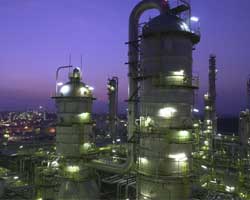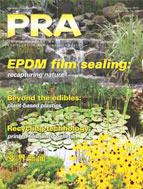 |
 |
In this Edition August 2011 |
LEAD FEATURE |
COMPANY NEWS |
MATERIALS NEWS |
MACHINERY NEWS |
INJECTION MOULDING ASIA |
PRA August 2011 Electronic Issue Now Available |
Lead Feature
Chemical companies face a new dilemma
 |
Recently, China's Fujia Petrochemical facility, which produces paraxylene, was told to shut its plant down as a result of pressure from local residents amid fears of a toxic spill. A storm damaged a dyke protecting the plant earlier this month and though the dyke had been repaired, residents protested over a possible chemical leak. (Flashback to radiation leaks from Japan's Fukushima Dai-Ichi nuclear power plant, crippled after an earthquake-triggered tsunami in March this year.)
Fujia is China's first privately owned petrochemical company. It is located in Dalian and started up in June 2009. Other than the 700,000 tonnes/year paraxylene plant, it also produces 350,000 tonnes/year of benzene and 100,000 tonnes/year of orthoxylene (since the massive protest by residents, there has been a complete news black-out on the plant's shut down).
Protestors called for the plant to be relocated, which in itself is not an easy task given that the liveable parts of the country are heavily populated. Industry analysts have said that if the Fujia plant is moved, because of its proximity to residential areas, then almost all the petrochemical plants in China will have to be shut or relocated. Moreover, the cost of the relocation will probably take a toll on Fujia's financials, since the complex was built at a cost of US$1.65 billion.
Encroaching into the environs
Protests are common in developed countries, too. Taiwan, recently, put the brakes on plans for its third refinery and petrochemical complex by Kuokuang Petrochemical Technology. An affiliate of Taiwan's state-run oil refiner CPC Corp, Kuokuang shelved plans to build the complex in the Dacheng Wetlands in Changhua County because protestors said it would harm the local oyster and eel-farming industries. Environmentalists also said the plant would consume huge amounts of water in a dry area, emit more than 7 million tonnes of carbon dioxide a year, pollute the air and harm local residents' health. In fact, Kuokuang had moved to Changhua because it had difficulty obtaining the approval of landowners and local governments at the original location it had selected.
The Taiwanese government is now facing growing pressure to allow upstream petrochemical industries to go to mainland China and to alternative destinations in Southeast Asia, to countries like Malaysia and Indonesia. But China has its own problems and environmental responsiveness is growing in Malaysia.
Gazetted industrial zones a sure way?
Even gazetted industrial zones have their share of problems. In 2009, Thailand's Map Ta Phut, in Rayong province, a hub for petrochemical companies, had 76 of its projects suspended by the government after environmental disputes. Residents living around Map Ta Phut, which is situated along the eastern seaboard of Thailand, had for years been complaining about the lack of clean water, air pollution and illegal dumping of waste. It reached boiling point in 2009.
Meanwhile, Malaysia recently forbade Australian rare earth supplier Lynas to continue building its plant in Gebeng, Kuantan, until the company complied with recommendations of a report commissioned by the International Atomic Energy Agency (IAEA). Many of the minerals mined by Lynas are used in a range of industrial and technology applications, like mobile phones, wind turbines and computer hard disks.
Local residents were concerned that the operation could cause lasting environmental damage and result in radiation leaks, although the IAEA mostly supported Lynas's contention that the plant would be safe. Recent reports say that the plant is on track to begin operating end of this year and that Lynas will be submitting its waste management plan to IAEA soon.
Residents probably had cause for concern as a rare earth plant set up in the 1980s in another township in Malaysia (Bukit Merah, in Taiping), has been linked to at least seven leaukemia-related deaths. Even though the plant shut down almost two decades ago in 1992, it is still undergoing a RM300 million clean-up exercise. (Flashback to US-based Union Carbide's chemical leak in Bhopal, India, and the radiation leak in Chernobyl, Russia.)
Lynas says it picked Gebeng as a location for its facility because it is a fully developed industrial estate and a hub for chemical and petrochemical companies. It has ample power and chemicals supply as well as skilled labour and is close to the port facility. It houses companies like BP Chemicals, Eastman Chemicals and BASF Petronas Chemicals, a 40:60 joint venture company between the national petroleum firm and German chemicals supplier BASF, which is also producing PBT in Gebeng, in another joint venture with Japanese firm Toray. Gebeng is also home to Japanese-owned Polyplastics that recently announced plans to invest RM600 million to quadruple the production of its engineering resins plant.
Are there any solutions?
The most obvious solution would be to undertake the appropriate feasibility, environmental and regulatory work prior to setting up a facility. But why build a new plant when there is no need to, ask analysts? Improving the efficiency of existing plants would allow for an increase in production and developing high-valued midstream and downstream products would allow for more value-added products on the market.
Another measure would be to exercise environmental management. For example, Thai corporation, SCG Chemicals, has earmarked an investment of 2.5 billion baht into environmental management in Map Ta Phut over the next six years and hopes that there will be no more disputes of the kind that prompted the government suspension (it has since been lifted after clarifications on environmental and health impact regulations) in 2009. Of the 76 projects that were affected, 20 belong to SCG and hence its interest in ensuring its meets its sustainability objectives.
A unit of Siam Cement Group, SCG says 17 of its plants will be turned into "eco-factories" emitting zero waste by 2013 and VOC-free by 2016. Somchai Wangwattanapanich, the Vice-President for Operations, was reported to have said the projects implemented between now and 2016 would share the objective of reducing energy consumption, noise and pollution from nitrogen oxide and volatile organic compounds (VOCs).
One way of reducing pollution will be to implement what is said to be Thailand's biggest enclosure ground flare (EGF), a device that will reduce smoke and noise from the production process. The EGF will allow complete combustion, thereby reducing the release of heat, flames and smoke into the air. SCG also plans to implement water treatment, waste management and build green zones, with construction to start next month for completion in late 2013.
The company says the massive investment will be on top of the 100 million baht/year it spends on corporate social responsibility activities.
Meanwhile, at SCG's joint venture with Japan's Mitsui Chemical, it will install an anaerobic wastewater treatment system that boasts lower electricity use compared to aerobic systems, and that generates biogas as a byproduct. On its website, Siam Mitsui says, "Nearly all the industrial waste produced is excess sludge generated in the wastewater treatment process, which used to make up a significant proportion of all sludge generated at our overseas affiliates in terms of quantity." The company has a system established to recycle this excess sludge in collaboration with a cement company in the Siam group.
Community development
SCG's Somchai has been reported to have said that the ultimate goal of the company is to turn its complex in Rayong into a full-scale industrial township. An effort of this scale would require community development. Last year, SCG and four other companies came together to form the Community Partnerships Initiative (CPI). Besides SCG, the initiative involves PTT, Dow Chemical, BLCP Power and Glow Group. It is aimed at establishing a new standard for industries living together with communities. The CPI has since been registered as an association and has become the Community Partnership Association (CPA). Of the 150 plants in the Map Ta Phut area, 60 have joined the CPA and have pledged to reduce VOC levels.
CPA members are said to have opened up their factories to villagers to observe their operations, with 750 villagers reported to have participated in these events.
Concerted efforts needed
There is not one solution to the situations at hand. It takes a concerted effort by governments to implement environmental legislations and companies to abide by these. For instance, residents of Map Ta Phut were the ones that brought the case against the eight Thai state agencies in relation to the health and environmental effects. The case alleged that these state agencies had issued operating permits illegally to the 76 industrial projects. These permits were alleged to be illegal because they bypassed Section 67 of the 2007 Constitution, which requires the government to hold public hearings and consider environmental and health impact assessments endorsed by the National Environment Board before issuing operating permits, in the case of projects which may have harmful effects on either the environment or the health of the people in the surrounding areas.
On their part, corporations need to ensure that environmental responsiveness is part of their agenda, especially in the light of global warming and erratic weather patterns in parts of the world, which is bringing with it problems not envisaged before.

